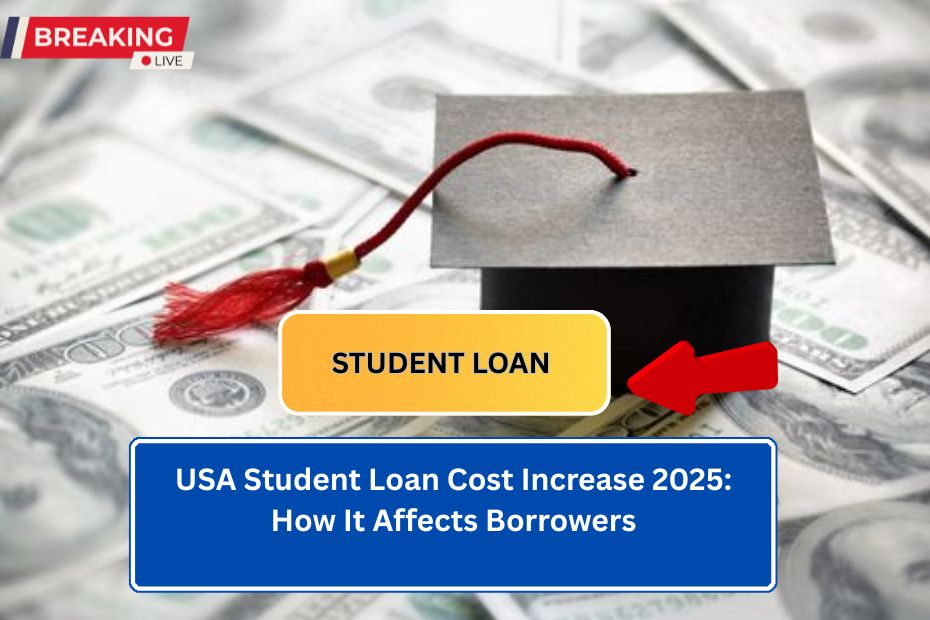In 2025, student loan borrowers across the United States are facing the highest borrowing costs seen in over a decade. The federal student loan interest rates for the 2024–2025 academic year have increased significantly, creating added financial pressure for students and families already coping with the rising cost of higher education.
Understanding these changes is essential for both current and future borrowers who want to make smart financial decisions and reduce the long-term impact of student debt.
Federal Student Loan Interest Rates for 2024–2025
The U.S. Department of Education adjusts federal student loan interest rates annually based on the 10-year Treasury note yield. For the 2024–2025 academic year, the following rates are in effect:
Undergraduate Loans (Direct Subsidized & Unsubsidized): 6.53% (up from 5.50%)
Graduate Loans (Direct Unsubsidized): 8.08% (up from 7.05%)
Parent PLUS & Grad PLUS Loans: 9.08% (up from 8.05%)
These rates are fixed once the loan is disbursed, meaning borrowers will be locked into these higher rates for the entire life of the loan.
What’s Driving the Rate Increase?
Several factors are contributing to the rise in student loan interest rates:
Federal Reserve Rate Hikes
The Federal Reserve has raised interest rates in response to ongoing inflation. These hikes influence all types of lending, including federal student loans.
Treasury Yield Changes
Student loan interest rates are tied to the 10-year Treasury yield. As these yields increase due to economic policy shifts and inflation, so do student loan rates.
Inflation and Economic Trends
With inflation driving up the cost of goods and services, borrowing has become more expensive. Students are now paying more not only for education but also for the money they borrow to afford it.
How This Impacts Borrowers
Higher interest rates mean borrowers will pay more over the life of their loans.
Example:
An undergraduate student borrowing $7,500 for the 2024–2025 school year will pay approximately $466 more in interest over a standard 10-year repayment term compared to the same loan taken out the previous year.
Graduate students and parents—who typically borrow larger sums—will face even steeper increases, potentially adding thousands of dollars to their total repayment amounts.
What Borrowers Can Do: Strategies to Reduce the Impact
1. Explore Income-Driven Repayment Plans
Plans like SAVE, REPAYE, and PAYE calculate monthly payments based on income and family size. These options can make student loans more affordable in the short term and may offer loan forgiveness after 20 to 25 years of payments.
2. Consider Private Refinancing (Carefully)
Borrowers with strong credit and stable income may qualify for lower interest rates through private lenders. But refinancing federal loans into private ones means losing access to federal protections, such as income-driven repayment, forbearance, and potential loan forgiveness.
3. Borrow Responsibly
Students should aim to borrow only what they truly need. Careful budgeting for tuition, housing, and other expenses can help minimize debt. Always exhaust federal loan options before considering private alternatives.
4. Stay Informed About Policy Changes
Student loan policies are constantly evolving. Recent developments include changes to the SAVE plan, court challenges, and proposals from both political parties that could reshape loan forgiveness and repayment structures.
Public Service Loan Forgiveness (PSLF)
The SAVE repayment plan
Income-based repayment eligibility
Political Landscape and Legislative Changes
The student loan system is facing ongoing political debate in 2025. Key developments include:
- Democratic lawmakers pushing to preserve and expand the SAVE repayment plan, despite legal challenges.
- Republican efforts, including proposals from former President Trump, to restrict eligibility for forgiveness programs like PSLF.
- Suggestions to shift student loan servicing responsibilities to agencies like the Small Business Administration, a move critics say could lead to delays or confusion.
Borrowers must monitor these developments closely, as changes could significantly impact repayment and forgiveness opportunities.
Final Thoughts: Prepare, Don’t Panic
The increase in student loan interest rates in 2025 is significant and will affect millions of borrowers. However, with the right strategies, it is possible to manage student loan debt effectively.
Being proactive—by exploring repayment plans, borrowing wisely, and staying informed—can help borrowers navigate this challenging financial landscape and protect their long-term financial health.
FAQ’s
Q1: Why did student loan interest rates increase in 2025?
A: The rates rose due to higher 10-year Treasury yields and Federal Reserve interest rate hikes aimed at controlling inflation.
Q2: How much more will students pay because of the rate increase?
A: An undergraduate borrowing $7,500 will pay around $466 more over 10 years compared to last year. Graduate and parent borrowers could pay thousands more.
Q3: Can I lower my student loan payments despite the higher rates?
A: Yes. Income-driven repayment plans like SAVE can reduce your monthly payments based on your income and family size.
